Beautiful Black and White Duck Breeds

Regarding waterfowl, the Black and White Duck is one of the most unique species in terms of physical appearance. This unusual duck is named for its distinct black and white plumage, which makes it easy to recognize. While its coloring seems reversed compared to the more common mallard, the Black and White Duck is a close relative of the American Black Duck.
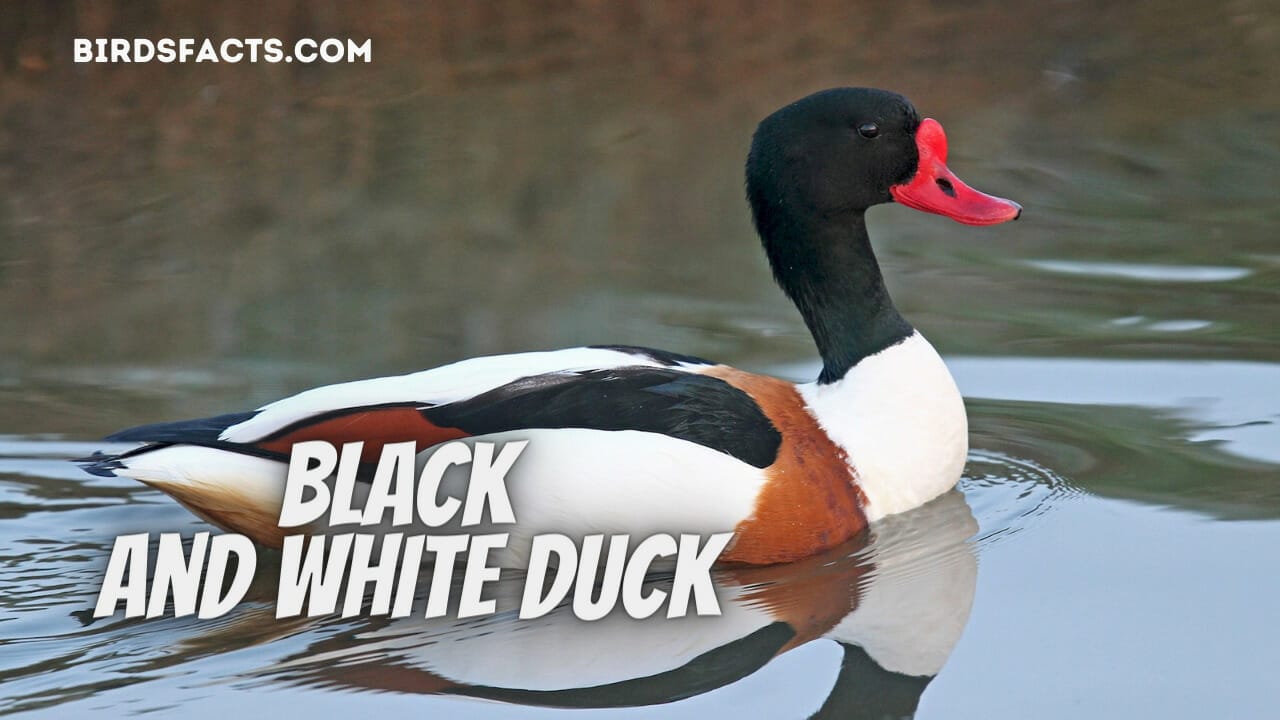
- Unique and striking appearance
- Named for its black and white plumage
- Related to the American Black Duck
From its habitat to its behavior, the Black and White Duck has fascinated researchers for years. Keep reading to discover more about this fascinating waterfowl species.
Black and White Duck
- Ancona Duck
- Magpie Duck
- Bufflehead
- Ring-necked Duck
- Hooded Merganser
- Common Merganser
- Common Goldeneye
- Lesser Scaup
- Red-breasted Merganser
- Greater Scaup
- Long-tailed Duck
- Common Eider
- Barrow’s Goldeneye
- King Eider
- Tufted Duck
- Spectacled Eider
- Common Pochard
- Smew
- Common Shelduck
- Muscovy Duck
- Bufflehead Duck
- White-winged Scoter
Ancona Duck
The Ancona Duck, also known as Anas platyrhynchos domesticus, is a domestic duck breed that originated in Ancona, Italy. These ducks are unique in many ways, with a striking appearance and exciting characteristics. Their most distinctive feature is their feather patterns, which are black and white, spotted or mottled.
Ancona ducks are mainly herbivores, and they feed on different plant materials. They also prey on insects, small fish, and amphibians. Ancona ducks are medium-sized duck breeds and can weigh up to 5 pounds. They have a wingspan of about 30 inches and can fly short distances. Ancona ducks have a lifespan of around 10 years and reach sexual maturity at 5 to 7 months.
These ducks usually mate and nest in the early spring and typically lay about 210 eggs yearly. The Ancona Duck is known for its hardiness in cold and wet climates, making them suitable for outdoor farming in many regions. However, their biggest threat is from predators such as raccoons, foxes, and snakes. In terms of population size, the Ancona Duck is considered a rare breed, with only a small number being bred and kept for domestic purposes. They come in various colors, such as blue, buff, and chocolate.
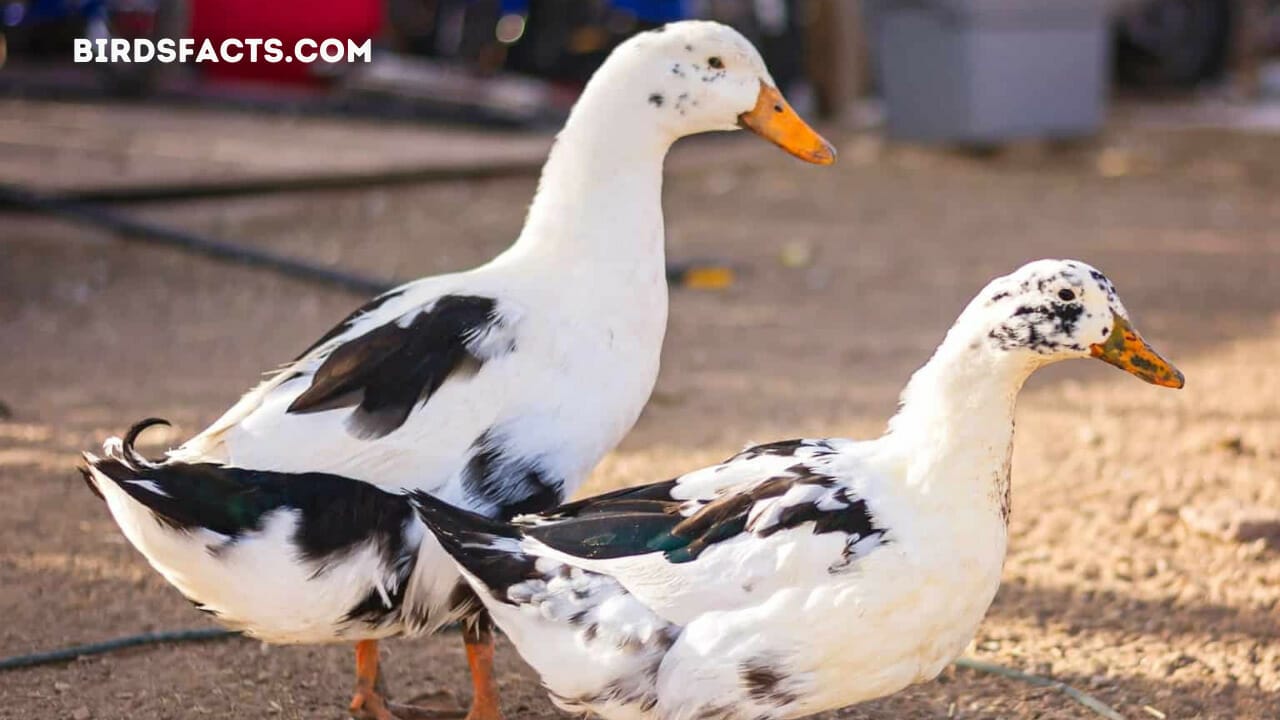
An attractive, fun fact about the Ancona Duck is that they are excellent egg layers, and their eggs are larger than those of other duck breeds. The eggs also have a longer shelf life. In conclusion, despite being a rare breed, the Ancona Duck is an exciting and unique species known for its distinctive feather patterns, hardiness, and excellent egg-laying abilities.
| Attribute | Information |
|---|---|
| Breed Name | Ancona Duck |
| Scientific Name | Anas platyrhynchos domesticus |
| Origin | Ancona, Italy |
| Feather Patterns | Black and white, spotted or mottled |
| Diet | Herbivorous (plants), insects, small fish, amphibians |
| Size | Medium-sized |
| Weight | Up to 5 pounds |
| Wingspan | Approximately 30 inches |
| Flying Ability | Short distances |
| Lifespan | Around 10 years |
| Sexual Maturity | 5 to 7 months |
| Breeding Season | Early spring |
| Egg Production | Approximately 210 eggs per year |
| Hardy in | Cold and wet climates |
| Predators | Raccoons, foxes, snakes |
| Population | Rare breed, small number kept domestically |
| Colors | Blue, buff, chocolate |
| Egg Characteristics | Larger size, longer shelf life |
Magpie Duck
The Magpie Duck, known by its scientific name Anas platyrhynchos domesticus, is a domesticated breed of duck that originated in the UK. It is named after its striking black and white plumage, which resembles that of the magpie bird. This breed is primarily used for ornamental purposes and as a source of meat and eggs.
Magpie Ducks are preyed upon by a variety of animals, including foxes and birds of prey, and their biggest threat comes from human activities such as hunting and habitat destruction. Their distinctive feature is their unique coloring, differentiating them from other domestic duck breeds. Magpie Ducks have a wingspan of around 30 inches and an incubation period of about 28 days.
They prefer open-water habitats such as ponds and lakes, and their diet consists of a mix of aquatic plants, insects, and small aquatic animals. Magpie Ducks are categorized as domesticated ducks, and there is currently only one recognized species. They are commonly found in many parts of the world, including North America and Europe. Magpie Ducks typically nest on the ground or in a shallow depression and begin molting at around 6-8 months of age.
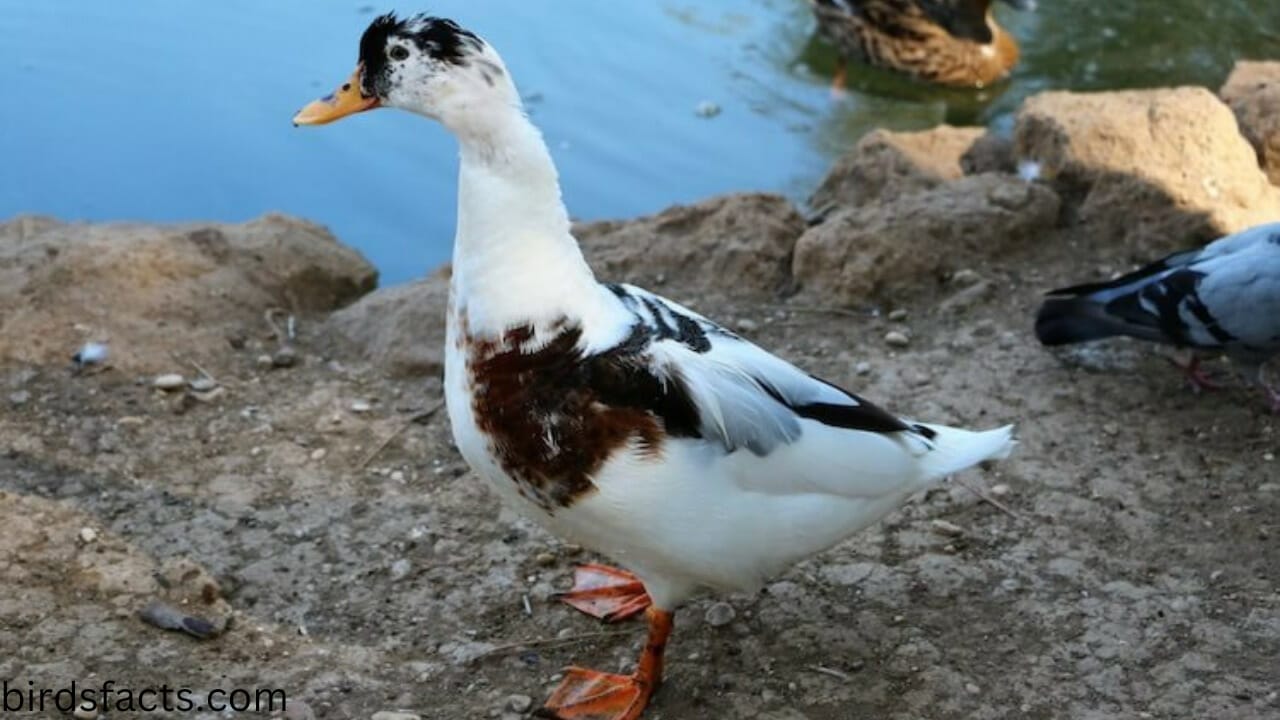
Their feathers can be black and white or blue and white, and they have a smooth, water-repellent skin type. Magpie Ducks have a top speed of around 45 miles per hour, a lifespan of about 8-12 years, and they can weigh up to 6-7 pounds and measure up to 24 inches in length.
| Topic | Information |
|---|---|
| Breed Name | Magpie Duck |
| Scientific Name | Anas platyrhynchos domesticus |
| Origin | United Kingdom |
| Description | The Magpie Duck is a domesticated breed of duck known for its black and white plumage resembling the magpie bird. |
| Uses | Ornamental purposes, meat, and eggs |
| Predators | Foxes, birds of prey, humans (hunting and habitat destruction) |
| Distinctive Feature | Unique black and white coloring |
| Wingspan | Approximately 30 inches |
| Incubation Period | Around 28 days |
| Habitat | Open-water habitats such as ponds and lakes |
| Diet | Aquatic plants, insects, small aquatic animals |
| Category | Domesticated duck |
| Species | One recognized species |
| Distribution | Found in various parts of the world, including North America and Europe |
| Nesting | Ground or shallow depression |
| Molting | Starts at around 6-8 months of age |
| Feathers | Black and white or blue and white |
| Skin Type | Smooth and water-repellent |
| Top Speed | Approximately 45 miles per hour |
| Lifespan | About 8-12 years |
| Weight | Up to 6-7 pounds |
| Length | Up to 24 inches |
Bufflehead
The Bufflehead, named Bucephala albeola, is a small diving duck species often appearing in wooded ponds and lakes. This species feeds primarily on insects, crustaceans, and small fish and can usually be found diving for prey in shallow water. One interesting fact about the Bufflehead is that they can attack up to 30 feet deep in search of food.
The estimated population size for this species is around 800,000 individuals. The biggest threat to this species is habitat loss and degradation, as wetlands are drained, and forests are cut down. The Bufflehead’s most distinctive feature is their striking black and white plumage, which helps them stand out from other ducks. They are also known as “butterballs” due to their round shape. This species has a wingspan of around 24 inches and an incubation period of about 29 days.
Male Bufflehead call
Female Bufflehead call
Buffleheads can be found in the northern regions of North America, with nesting locations being in tree cavities or nest boxes. They begin molting at around one year old, and adults have a distinct black-and-white coloration. The Bufflehead falls under the category of diving ducks and is one of eight species in North America. Their skin is covered in waterproof feathers, and they can reach up to 40 miles per hour.

The average lifespan for a Bufflehead is around 5-6 years, with a weight of about 13-20 ounces and a length of about 13-16 inches. Buffleheads are a small but striking species with unique black-and-white coloring and impressive diving abilities.
| Species | Bufflehead |
|---|---|
| Scientific Name | Bucephala albeola |
| Habitat | Wooded ponds and lakes |
| Primary Diet | Insects, crustaceans, and small fish |
| Diving Depth | Up to 30 feet |
| Population Size | Approximately 800,000 individuals |
| Threats | Habitat loss and degradation |
| Distinctive Feature | Striking black and white plumage |
| Nickname | “Butterballs” |
| Wingspan | Around 24 inches |
| Incubation Period | Approximately 29 days |
| Distribution | Northern regions of North America |
| Nesting Locations | Tree cavities or nest boxes |
| Molting | Begins at around one year old |
| Duck Category | Diving ducks |
| Species in North America | One of eight species |
| Speed | Up to 40 miles per hour |
| Lifespan | Around 5-6 years |
| Weight | 13-20 ounces |
| Length | 13-16 inches |
Ring-necked Duck
The Ring-necked Duck, scientific name Aythya collaris, is a fascinating waterbird species found in North America. These ducks are medium-sized and have distinctive, dark head with a white ring around their necks. Their wingspan ranges from 23 to 30 inches, and they weigh between 1.4 to 2.3 pounds, with females usually smaller than males. The Ring-necked Duck eats a diverse diet that includes aquatic plants, invertebrates, crustaceans, and small fish.
They are primarily found in freshwater habitats such as ponds, lakes, and marshes during the breeding season and in coastal areas and estuaries during migration and winter.
The Ring-necked Duck’s nesting location is usually close to water, in tree cavities, or among cattails. They lay an average of about six to 14 eggs per clutch, with an incubation period of about 25 to 29 days. They molt once a year, at around one year of age, gradually acquiring their distinct breeding plumage. Their lifespan ranges from three to five years in the wild, but they can live longer in captivity.
The Ring-necked Duck’s most distinctive feature is the white ring around their necks, which can be difficult to see unless seen up close. They are often called “Ringbill” or “Blackjack” because of their unique characteristics and black wings. The estimated population of Ring-necked Duck is approximately 2.8 million birds.
The biggest threat to the Ring-necked Duck is habitat loss caused by development, which reduces the suitable breeding habitat for these ducks. Predators of the Ring-necked Duck include snapping turtles, snakes, raccoons, and birds of prey.
Ring-necked Duck Calls:
In conclusion, the Ring-necked Duck is an intriguing species with unique characteristics that make them stand out in the wild. They inhabit freshwater habitats and have a diverse diet, eating aquatic plants, invertebrates, crustaceans, and small fish. Unfortunately, habitat loss remains the biggest threat to their survival.
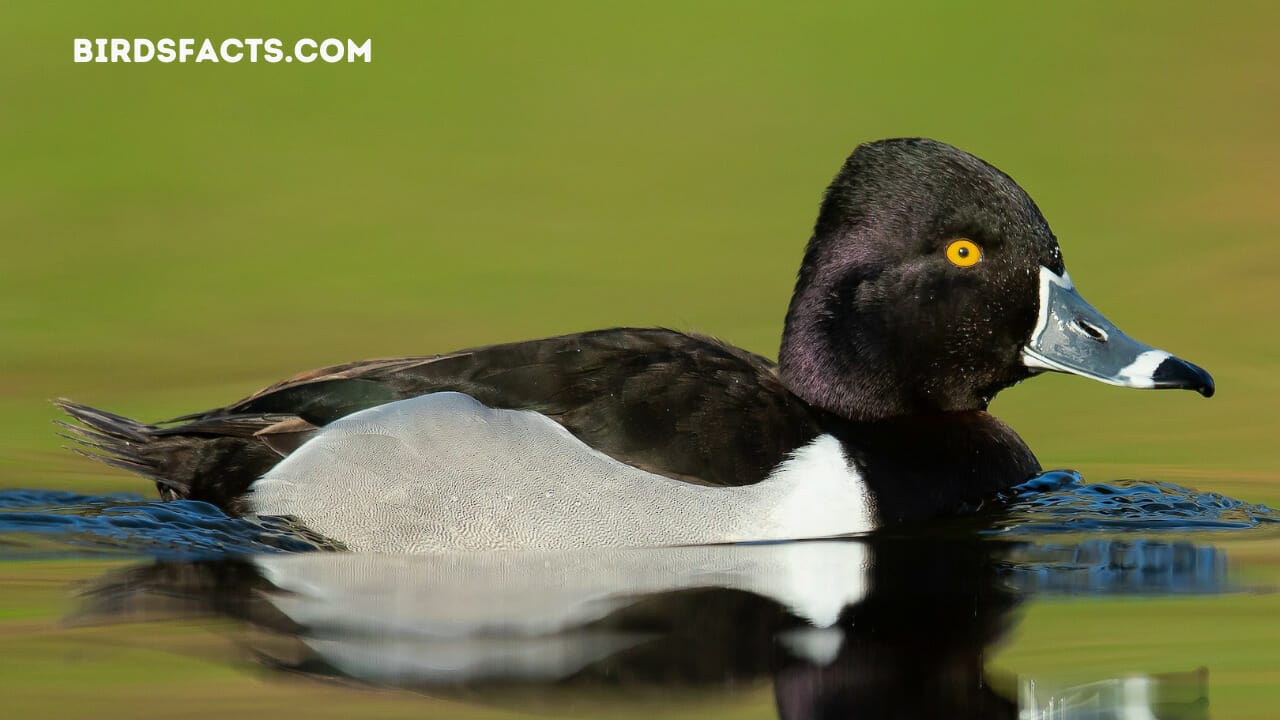
Overall, their white collar and sleek black plumage make the Ring-necked Duck an exciting and stunning species to observe in its natural habitat.
| Species | Ring-necked Duck |
|---|---|
| Scientific Name | Aythya collaris |
| Description | Medium-sized waterbird with dark head and white ring around neck |
| Wingspan | 23 to 30 inches |
| Weight | 1.4 to 2.3 pounds (females smaller than males) |
| Diet | Aquatic plants, invertebrates, crustaceans, small fish |
| Habitat | Freshwater habitats (ponds, lakes, marshes), coastal areas, estuaries |
| Nesting Location | Close to water, tree cavities, among cattails |
| Eggs per Clutch | Average of 6 to 14 |
| Incubation Period | 25 to 29 days |
| Molt | Once a year, around one year of age |
| Breeding Plumage | Distinctive with white collar |
| Lifespan | 3 to 5 years (wild), longer in captivity |
| Population | Approximately 2.8 million birds |
| Threats | Habitat loss, predators (snapping turtles, snakes, raccoons, birds of prey) |
Hooded Merganser
The Hooded Merganser, scientifically named Lophodytes cucullatus, is a small, crested duck found mainly in North America. These ducks are known for their unique and striking appearance, particularly their prominent hood-shaped crest, which gives them their name. The Hooded Merganser’s most distinctive feature is their black and white plumage and bright yellow eyes, giving them a unique and unmistakable look.
These ducks have a wingspan of approximately 1.5 feet and can weigh up to 1.5 pounds, with a length of around 18 inches. They are also known for their impressive speed, capable of reaching up to 60 miles per hour when diving for prey.
The Hooded Merganser’s primary diet consists of small fish, crustaceans, and aquatic insects, which they hunt by diving into the water and using their sharp, serrated bill to catch prey. They are primarily found in freshwater habitats, including ponds, streams, and swamps. Although they are small birds, Hooded Mergansers have a lifespan of up to 12 years, which is impressive for their size. During the breeding season, these ducks are known to nest in tree cavities near water or abandoned woodpecker holes, which provides them with the protection they need to incubate their eggs and raise their young.
The estimated population size of the Hooded Merganser is challenging to determine, but it is believed to be stable, with an estimated 250,000 breeding adults in North America. However, the biggest threat to their population is the loss of habitat due to human development and pollution, which can impact their ability to find food and breed successfully.
Male Hooded Merganser cal
Female Hooded Merganser call

It is also worth noting that the Hooded Merganser is sometimes referred to as the Hoodie or Little Hoodie, and they are one of three species of mergansers found in North America. Despite their small size, these ducks are impressive and charismatic, making them a favorite among birdwatchers and nature enthusiasts.
| Attribute | Information |
|---|---|
| Common Name | Hooded Merganser |
| Scientific Name | Lophodytes cucullatus |
| Habitat | Freshwater habitats such as ponds, streams, and swamps |
| Distribution | Mainly found in North America |
| Appearance | Small duck with a prominent hood-shaped crest, black and white plumage, and bright yellow eyes |
| Size | Wingspan: Approximately 1.5 feet<br>Weight: Up to 1.5 pounds<br>Length: Around 18 inches |
| Speed | Capable of reaching up to 60 miles per hour when diving for prey |
| Diet | Small fish, crustaceans, and aquatic insects |
| Lifespan | Up to 12 years |
| Breeding | Nests in tree cavities near water or abandoned woodpecker holes |
| Population Size | Estimated 250,000 breeding adults in North America |
| Conservation Status | Stable (subject to habitat loss due to human development and pollution) |
| Other Names | Hoodie or Little Hoodie |
| Other Species | One of three species of mergansers found in North America |
| Characteristics | Impressive speed and charismatic nature |
Common Merganser
The Common Merganser, or Mergus merganser, is a species of duck found throughout North America, Europe, and Asia. These birds are known for their distinctive features, including a long, narrow bill and a crested head. They are also easily identifiable by their black and white plumage, with males having a green head and females having a reddish-brown head. The Common Merganser is a diving duck that feeds primarily on fish but will also eat crustaceans, mollusks, and insects. They are known for their impressive wingspan, reaching three feet long.
In terms of habitat, Common Mergansers are most commonly found in freshwater areas such as lakes, rivers, and ponds. They tend to nest in hollow trees but can also use artificial structures such as nesting boxes. Incubation takes roughly 30 days, and the chicks will fledge after about 70 days.
While the Common Merganser has a relatively large estimated population size, its most significant threat is habitat loss due to human development. They are also vulnerable to pollution and predation by animals, such as mink, raccoons, and eagles.
One fun fact about Common Mergansers is that they are known for their unique courtship displays, which involve the male offering his mate fish during courtship. They are sometimes called “fish ducks” due to their diet.
Regarding other names, the Common Merganser is also known as the goosander in Europe and the sawbill in North America. There is only one species of Common Merganser, but they can be found in a variety of locations throughout the world.
Male Common Merganser call
Female Common Merganser call

The Common Merganser can weigh up to 6 pounds and reach a length of up to 27 inches, making them a relatively large species of duck. They have waterproof feathers and can swim up to 49 miles per hour. Their average lifespan is around 8 years, and they typically begin molting at about two years of age.
| Topic | Information |
|---|---|
| Species | Common Merganser |
| Scientific Name | Mergus merganser |
| Description | The Common Merganser is a species of duck found throughout North America, Europe, and Asia. They have a long, narrow bill and a crested head. Males have a green head, while females have a reddish-brown head. They have black and white plumage and a three-foot wingspan. |
| Habitat | Freshwater areas such as lakes, rivers, and ponds |
| Nesting Habits | Hollow trees or artificial structures like nesting boxes |
| Incubation Period | Approximately 30 days |
| Fledging Period | About 70 days |
| Threats | Habitat loss, pollution, predation by animals (e.g., mink, raccoons, eagles) |
| Courtship Display | Male offers fish to the female |
| Alternative Names | Goosander (Europe), Sawbill (North America) |
| Size | Up to 6 pounds in weight, up to 27 inches in length |
| Swimming Speed | Up to 49 miles per hour |
| Lifespan | Around 8 years |
| Molting | Begins at about two years of age |
Common Goldeneye
The Common Goldeneye, the scientific name Bucephala clangula, is a medium-sized duck species in North America and Europe. These birds are primarily aquatic and feed on a valley and invertebrates. They can dive up to 20 feet deep to catch their prey. A fun fact about Common Goldeneyes is that they have unique courtship displays where males will bob their heads and inflate their white cheek feathers to attract a mate.
The estimated population size for these birds is around 700,000 individuals worldwide. Their biggest threat is habitat destruction and pollution, which can impact their food sources and nesting areas. The most distinctive feature of the Common Goldeneye is its striking black and white plumage, with a golden-yellow eye. They are also commonly known as Whistlers due to their high-pitched whistle vocalizations.
With a wingspan of up to 30 inches, these birds typically incubate their eggs for around a month before hatching them in tree cavities near water. Common predators include large birds of prey and raccoons. As for their diet, Common Goldeneyes are considered diving ducks and consume mainly aquatic invertebrates anducksall fish. They are categorized as a dabbling duck, which refers to their feeding behavior of tipping headfirst into the water to reach their food.
Common Goldeneye Male
Common Goldeneye Alarm call
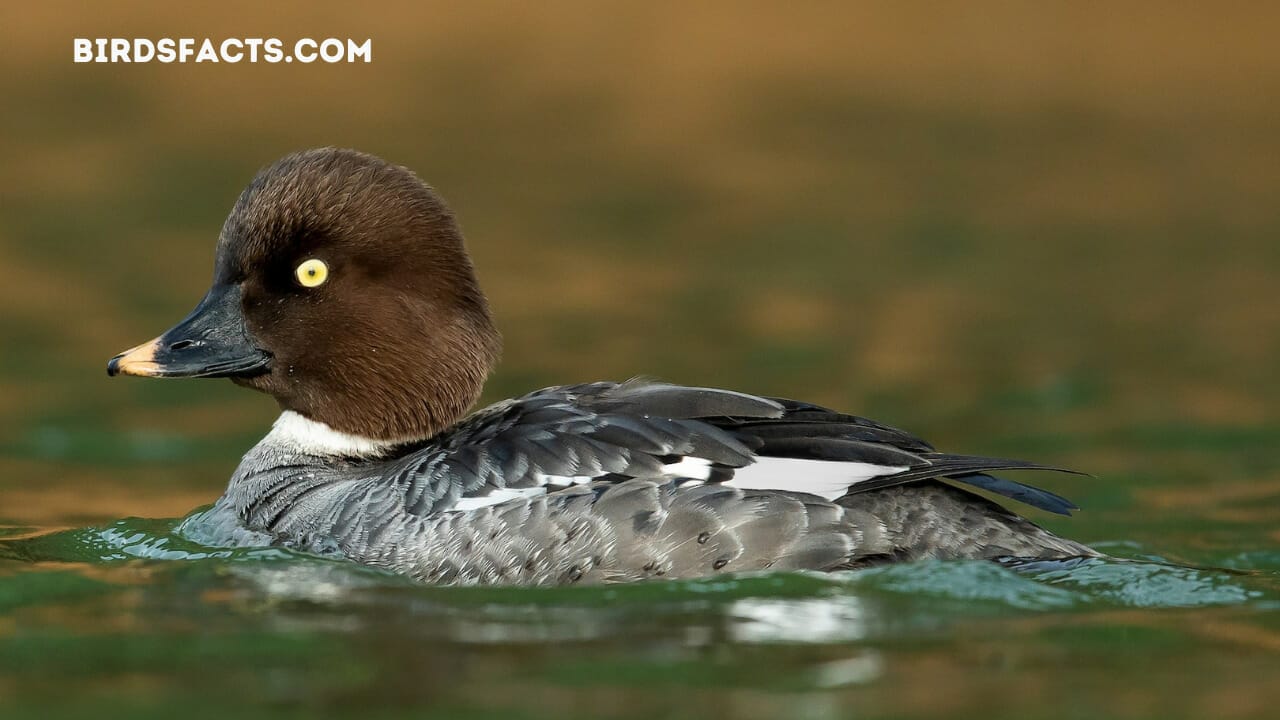
The lifespan for these birds can reach up to 12 years, and they typically weigh around 2 pounds with a length of 18-20 inches. Overall, the Common Goldeneye is a fascinating and beautiful bird with adapted skills for thriving in aquatic environments.
| Information | Description |
|---|---|
| Scientific Name | Bucephala clangula |
| Common Name | Common Goldeneye |
| Habitat | North America and Europe |
| Size | Medium-sized |
| Primary Diet | Aquatic invertebrates and valley |
| Diving Depth | Up to 20 feet |
| Courtship Display | Males bob heads and inflate white cheek feathers to attract a mate |
| Population Size | Approximately 700,000 worldwide |
| Threats | Habitat destruction and pollution affecting food sources and nesting areas |
| Plumage | Striking black and white with golden-yellow eye |
| Common Name (Alternate) | Whistlers |
| Vocalizations | High-pitched whistle |
| Wingspan | Up to 30 inches |
| Incubation Period | About a month |
| Nesting Habitat | Tree cavities near water |
| Predators | Large birds of prey and raccoons |
| Feeding Behavior | Dabbling duck; tips headfirst into the water to reach food |
| Lifespan | Up to 12 years |
| Weight | Approximately 2 pounds |
| Length | 18-20 inches |
| Adaptations | Thrives in aquatic environments |
Lesser Scaup
The Lesser Scaup (Aythya affinis), also known as bluebill, is a species of diving duck found tducksghout North America. They are medium-sized duck with a wingspan of about 23 inches and a length of around 15 inches. Lesser Scaups are also known for their variously-grey bill.
They can be found in various freshwater habitats, including lakes, ponds, and rivers. Their diet consists mainly of aquatic plants, insects, and small animals. During the breeding season, Lesser Scaups build their nests close to water bodies and incubate their eggs for 22-28 days. Interestingly, young Lesser Scaups molt into their adult plumage within the first year of their life.
The estimated population size of Lesser Scaups is around 5 million individuals, and their biggest threat is habitat loss due to human development. Their incentive feature is their blue-grey bill, unlike any other duck species. Among hunters, Lesser Scaups are prized for their delicious meat and are often hunted for sport. They are also preyed upon by various predators, such as foxes and bald eagles. Despite being a common species, Lesser Scaups are facmultipleulation deRegardingrtain regions due to multiple threats.
Regarding physical characteristics, Lesser Scaups have a brownish-grey body with a white chest and sides. They have a bluish-grey bill, yellow eyes, and striking white wing patches visible in flight. Their skin type is waterproof and covered in feathers for warmth.
Male Lesser Scaup
Female Lesser Scaup
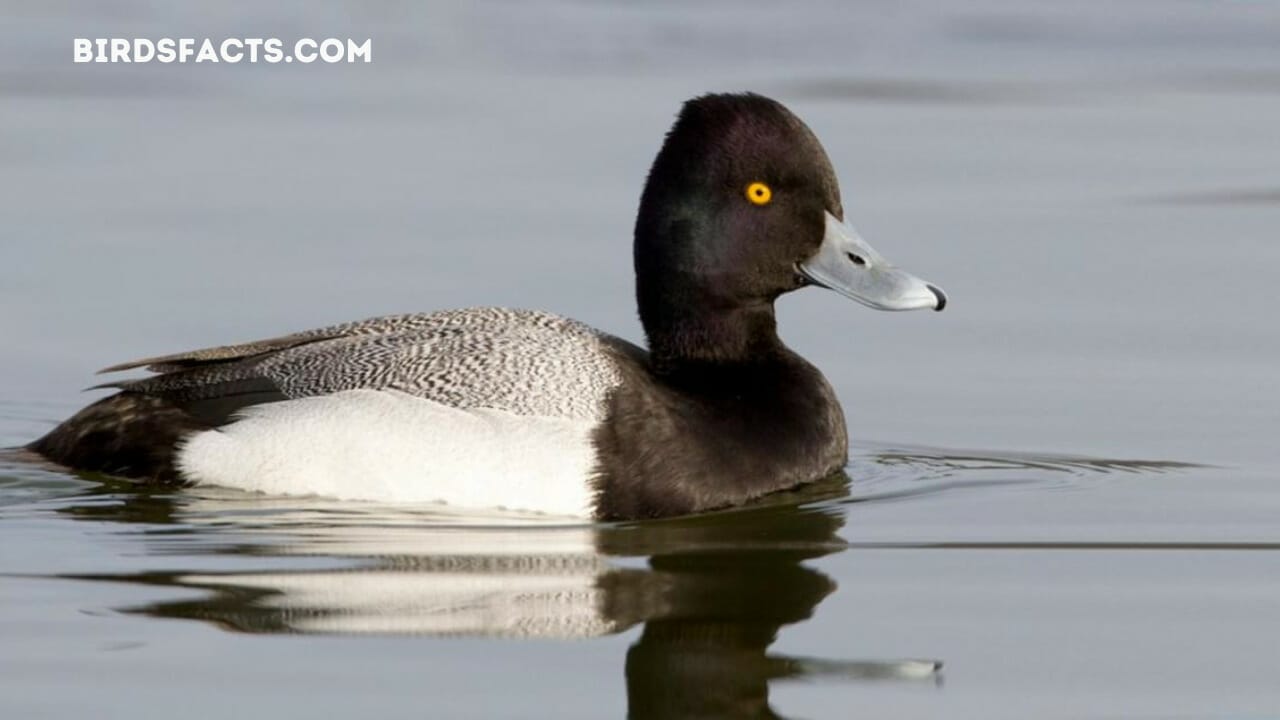
Lesser Scaups can reach top speeds of around 50 mph and have a lifespan of up to 7 years in the wild. Their average weight is around 1.2 pounds, and they can molt into their adult plumage as early as 60 days after hatching. Overall, the Lesser Scaup is a fascinating species widely distributed across North America and plays a vital role in the ecosystem.
| Information | Description |
|---|---|
| Scientific Name | Aythya affinis |
| Common Name | Lesser Scaup |
| Alternate Name | Bluebill |
| Habitat | Freshwater habitats including lakes, ponds, and rivers |
| Size | Medium-sized |
| Wingspan | Approximately 23 inches |
| Length | Around 15 inches |
| Bill Color | Various shades of grey |
| Diet | Aquatic plants, insects, small animals |
| Breeding Nesting Period | 22-28 days |
| Plumage Transformation | Young molt into adult plumage within the first year |
| Population Size | Approximately 5 million individuals worldwide |
| Threats | Habitat loss due to human development |
| Distinctive Feature | Blue-grey bill |
| Hunting Value | Prized for delicious meat and hunted for sport |
| Predators | Foxes, bald eagles, and other predators |
| Regional Status | Facing population decline in certain regions due to multiple threats |
| Body Color | Brownish-grey with white chest and sides |
| Bill Color | Bluish-grey |
| Eye Color | Yellow |
| Wing Patches | Striking white patches visible in flight |
| Skin Type | Waterproof, covered in feathers for warmth |
| Top Speed | Around 50 mph |
| Lifespan | Up to 7 years in the wild |
| Weight | Approximately 1.2 pounds |
| Plumage Transformation Period | As early as 60 days after hatching |
Red-breasted Merganser
The Red-breasted Merganser scientifically, also known as Mergus serrator, is a diving duck in North America, Europe, and Asia. These ducks are known for their distinctive features, such as their pointed red or orange bills, blackish-green crests, and bold black-and-white patterns on their bodies. The males have an iridescent green head, while the females are brown with a reddish-brown head. Red-breasted mergansers have a wingspan of approximately 27 inches and can grow up to 20 inches long.
These diving ducks inhabit coastal waters, estuaries, and freshwater wetlands. They nest on the ground, typically near the water’s edge, and incubate their eggs for around 27 days. Young Red-breasted Mergansers start molting at around 60 days old, losing their flight feathers and becoming flightless for about a month.
The Red-breasted Mergansers feed on fish and eat crustaceans, mollusks, and insects. Their predators include Bald Eagles, Northern Goshawks, and Great Horned Owls. The estimated global population size is around 1.2 million birds, with the most significant threat being habitat loss due to human development along the coasts.
A fun fact about these diving ducks is that they have a special membrane covering their eyes while they swim underwater, allowing them to see clearly without the risk of getting water. Red-breasted Mergansers are also called Saws Bill due to their serrated bill and Common Merganser due to their similarities to other Merganser species.
Male Red-breasted Merganser
Female Red-breasted Merganser

In conclusion, the Red-breasted Merganser is a fascinating diving duck with unique characteristics. They are commonly found in various coastal and freshwater wetland habitats and primarily feed on fish. Their biggest threat is habitat loss, and conservation efforts are necessary to ensure their population continues to thrive.
| Species Name | Red-breasted Merganser |
|---|---|
| Scientific Name | Mergus serrator |
| Geographic Distribution | North America, Europe, Asia |
| Distinctive Features | Pointed red or orange bills, blackish-green crests, bold black-and-white patterns |
| Male Appearance | Iridescent green head |
| Female Appearance | Brown with reddish-brown head |
| Wingspan | Approximately 27 inches |
| Length | Up to 20 inches |
| Habitat | Coastal waters, estuaries, freshwater wetlands |
| Nesting Behavior | Ground nests near water’s edge |
| Incubation Period | Around 27 days |
| Molting Period | Starts at around 60 days old, flightless for about a month |
| Diet | Fish, crustaceans, mollusks, insects |
| Predators | Bald Eagles, Northern Goshawks, Great Horned Owls |
| Global Population Size | Approximately 1.2 million birds |
| Threats | Habitat loss due to human development along coasts |
| Special Feature | Membrane covering eyes for clear vision underwater |
| Other Names | Saws Bill, Common Merganser |
| Conservation Importance | Conservation efforts needed to protect population |
Greater Scaup
The Greater Scaup, also known as Aythya marila, is a species of diving duck in North America, Europe, and Asia. These birds feed primarily on mollusks, crustaceans, and aquatic insects in freshwater and saltwater habitats. With an estimated population size of around 4 million individuals, the Greater Scaup is considered a minor concern regarding threat level. However, oil and gas drilling, hunting, and habitat loss are all potential dangers to these birds.
Their most distinctive feature is their dark feathers and greenish-black head opposite their light-colored flanks. Some other names for these birds include the broadbill, bluebill, raftsman, and blackhead. With a wingspan of around 77cm, a length of 38cm, and a weight of 800g, these ducks are medium-sized for their species. During incubation, typically 23-29 days, males and females take turns tending to their brood.
Their nesting locations include northern wetlands, marshes, and the tundra. While the main predators of these birds include bald eagles, peregrine falcons, and gulls that prey on eggs and ducklings, foxes and minks target adult ducks. Greater Scaups are medium to fast flyers, with a top airspeed of approximately 65 km/h.
Greater Scaup flight call
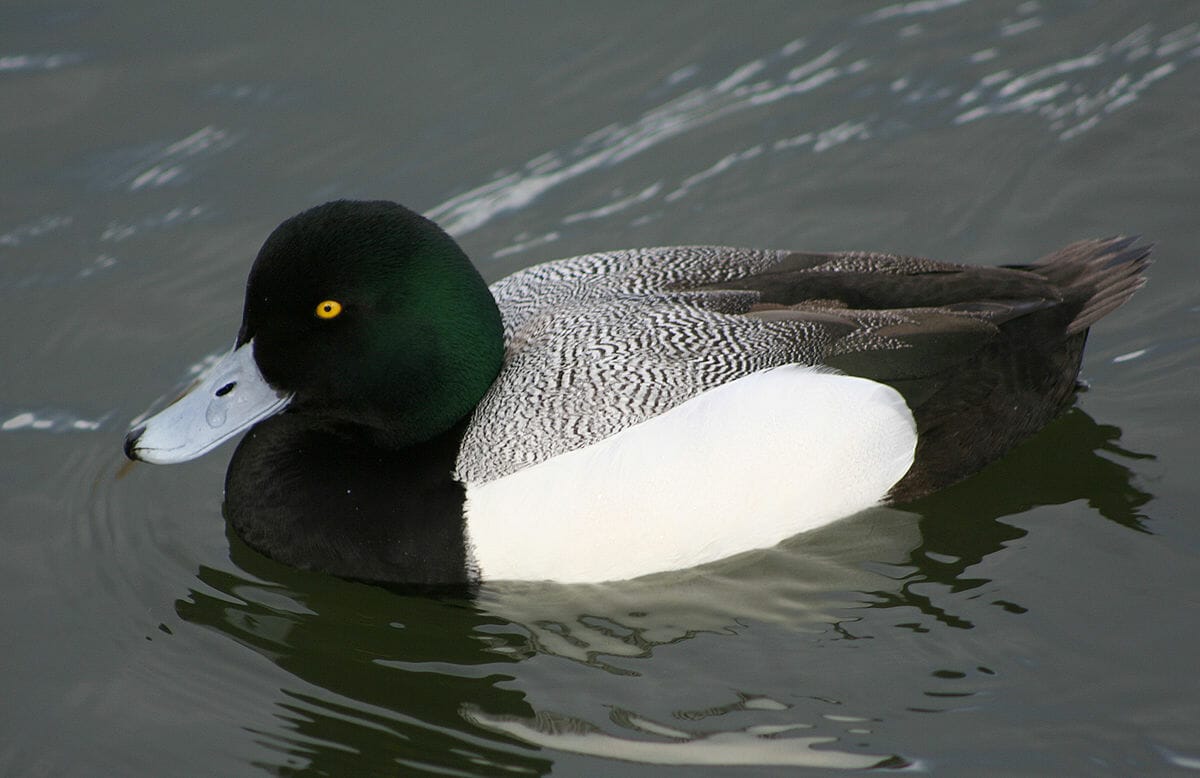
These ducks’ skins are covered in waterproof feathers, allowing them to stay dry underwater. Greater Scaups can live up to 18 years in the wild, reaching maturity at around one year. The males’ black and white mark on their necks appears during their first molt, which generally occurs at six to seven months old.
| Species Name | Greater Scaup |
|---|---|
| Scientific Name | Aythya marila |
| Geographic Distribution | North America, Europe, Asia |
| Primary Diet | Mollusks, crustaceans, aquatic insects |
| Population Size | Approximately 4 million individuals |
| Threat Level | Minor concern |
| Potential Threats | Oil and gas drilling, hunting, habitat loss |
| Distinctive Features | Dark feathers, greenish-black head, light-colored flanks |
| Other Names | Broadbill, Bluebill, Raftsman, Blackhead |
| Wingspan | Approximately 77 cm |
| Length | 38 cm |
| Weight | 800 g |
| Incubation Period | Typically 23-29 days |
| Nesting Locations | Northern wetlands, marshes, tundra |
| Parental Care | Males and females take turns tending to the brood |
| Predators | Bald Eagles, Peregrine Falcons, Gulls, Foxes, Minks |
| Flight Characteristics | Medium to fast flyers, top airspeed of approximately 65 km/h |
| Waterproofing Adaptation | Skins covered in waterproof feathers |
| Lifespan | Up to 18 years in the wild |
| Age of Maturity | Around one year |
| Molt and Neck Mark | First molt occurs at six to seven months old, black and white mark on the neck appears |
Long-tailed Duck
The Long-tailed Duck, also known as the Oldsquaw, is a sea duck found in the Arctic and subarctic regions of the Northern Hemisphere. Its scientific name is Clangula hyemalis. This duck is a diving bird and feeds primarily on the ocean and freshwater invertebrates, including crustaceans, mollusks, and even small fish. Its most distinctive feature is its long tail feathers, measuring up to 6 inches long.
The Long-tailed Duck is generally seen in pairs or small flocks and is a migratory bird that spends breeding seasons in the Arctic tundra and winters along the coastal waters of the open sea. Their breeding habitat is typically found near the sea, offshore islands, or coastal mainland. Predators such as gulls, eagles, and falcons prey on Long-tailed Ducks while swimming, diving, or during the breeding season.
The duck molts after breeding and loses its colorful plumage and split-tail feathers to turn brownish-gray in color, which helps it blend in with the surrounding environment. The Long-tailed Duck can reach speeds of up to 60 miles per hour. The estimated population size of this species is around 1 million, and the biggest threat to its survival is climate change and the resulting impact on habitat and food sources.
Male Long-tailed Duck
Female Long-tailed Duck

The average lifespan of Long-tailed Ducks is 7-10 years, and they generally weigh 1.5-2 pounds and can measure up to 23 inches in length with a wingspan of 28 inches. The Long-tailed Duck’s incubation period typically lasts around 24-28 days.
| Attribute | Information |
|---|---|
| Common Name | Long-tailed Duck |
| Scientific Name | Clangula hyemalis |
| Habitat | Arctic and subarctic regions of the Northern Hemisphere |
| Feeding Habits | Primarily feeds on ocean and freshwater invertebrates, including crustaceans, mollusks, and fish |
| Distinctive Feature | Long tail feathers measuring up to 6 inches long |
| Behavior | Seen in pairs or small flocks; migratory bird; breeds in Arctic tundra and winters along coastal waters |
| Breeding Habitat | Near the sea, offshore islands, or coastal mainland |
| Predators | Gulls, eagles, and falcons while swimming, diving, or during breeding season |
| Molting | After breeding, loses colorful plumage and split-tail feathers, turns brownish-gray |
| Speed | Can reach speeds of up to 60 miles per hour |
| Population Size | Estimated around 1 million |
| Threats | Climate change impacting habitat and food sources |
| Lifespan | 7-10 years |
| Weight | 1.5-2 pounds |
| Length | Up to 23 inches |
| Wingspan | 28 inches |
| Incubation Period | 24-28 days |
Common Eider
The Common Eider is a well-known sea duck species scientifically known as Somateria mollissima. This duck is known for its unique physical characteristics and behavior. The Common Eider feeds on various prey, such as crustaceans, mollusks, and small fish. A fascinating fact about this duck is that it can dive up to 200 feet deep in search of food. The estimated population size of Common Eiders is around 250,000 individuals worldwide.
The biggest threat to their population is human disturbance and climate change. The most distinctive feature of the Common Eider is its soft and warm down feathers, which humans use for insulation. It is also known as King Eider and has a wingspan of up to 4 feet. The incubation period for Common Eiders is around 25-28 days, and they typically nest near shorelines in the Arctic regions. The predators of this duck include arctic foxes, gulls, and skuas.
The Common Eider’s diet is varied, and they are omnivorous animals. They can feed on different types of plants and small animals. This duck is a type of seabird and is commonly known as the eider duck. Four subspecies of the Common Eider are found in various locations, such as North America, Europe, and Asia. The nesting location for these ducks is on rocky cliffs, where they can easily access the water.
Common Eiders’ molting age is around 9-11 months, and their striking black and white plumage characterizes them. They have a thick skin type that helps them adapt to harsh oceanic climates. Common Eiders are known for their impressive top speed of up to 60 miles per hour and have a lifespan of up to 20 years.
Male Common Eider
Female Common Eider
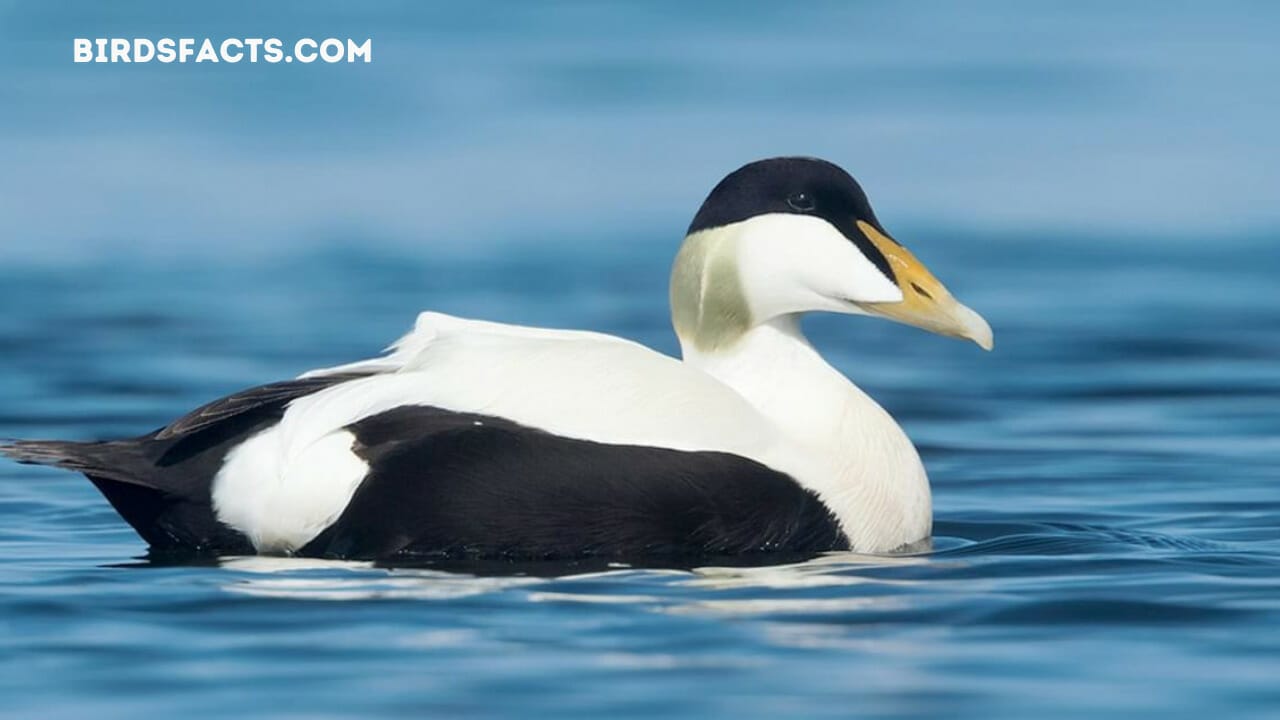
The weight and length of the Common Eider can vary depending on the subspecies, but they can weigh between 3-11 pounds and grow up to 30 inches in length. Overall, the Common Eider is a unique and fascinating sea duck with a significant role in oceanic ecosystems.
| Attribute | Information |
|---|---|
| Scientific Name | Somateria mollissima |
| Common Name | Common Eider |
| Physical Features | Soft and warm down feathers, wingspan up to 4 feet |
| Behavior | Dives up to 200 feet deep in search of food |
| Population Size | Approximately 250,000 individuals worldwide |
| Threats | Human disturbance, climate change |
| Incubation Period | 25-28 days |
| Nesting Habitat | Rocky cliffs near shorelines in Arctic regions |
| Predators | Arctic foxes, gulls, skuas |
| Diet | Omnivorous, feeds on crustaceans, mollusks, small fish, plants |
| Subspecies | Four subspecies found in North America, Europe, and Asia |
| Molting Age | 9-11 months |
| Plumage | Striking black and white plumage |
| Adaptations | Thick skin to withstand harsh oceanic climates |
| Top Speed | Up to 60 miles per hour |
| Lifespan | Up to 20 years |
| Weight | 3-11 pounds |
| Length | Up to 30 inches |
Barrow’s Goldeneye
Barrow’s Goldeneye is a sea duck found in North America. Its scientific name is Bucephala islandica. The diet of Barrow’s Goldeneye consists mainly of aquatic insects and crustaceans. A fun fact about this bird is that it can dive up to 60 feet below the water’s surface in search of food. The estimated population size of Barrow’s Goldeneye is around 90,000, with numbers decreasing due to habitat loss and hunting.
Its most significant threat is pollution and loss of habitat due to human activity. This bird’s most distinctive feature is its striking head, which contrasts sharply with its dark body. Barrow’s Goldeneye is also known as “Barrow’s Duck.” Its wingspan is approximately 28 inches, and the incubation time for its eggs is around 30 days.
These birds can be found in habitats such as large rivers, estuaries, and coastal bays. Common predators of Barrow’s Goldeneye include eagles, foxes, and minks. The lifespan of this bird is around 12 years, and it can weigh up to 2.5 pounds and grow up to 20-21 inches long. It takes on a drabber appearance during molting with reduced wings that last about three weeks.
Barrow’s Goldeneye call:
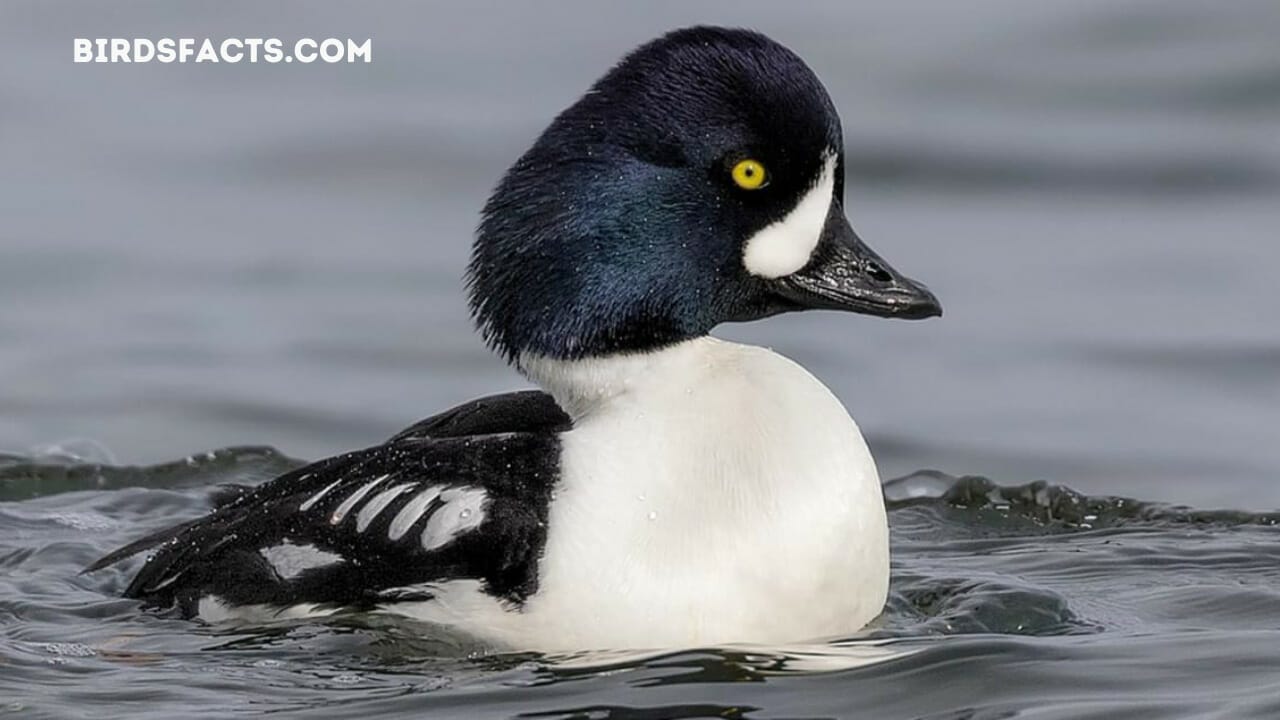
Its plumage varies according to sex, but it generally has a dark black/iridescent purple head, a white spot on the cheek, and a light gray body. Barrow’s Goldeneye is a type of diving duck with only two other species in its genus. Its nesting location is usually in tree cavities near water. Regarding speed, Barrow’s Goldeneye can swim up to 50 miles per hour.
| Attribute | Information |
|---|---|
| Common Name | Barrow’s Goldeneye |
| Scientific Name | Bucephala islandica |
| Habitat | Large rivers, estuaries, coastal bays |
| Geographic Range | North America |
| Diet | Aquatic insects, crustaceans |
| Diving Depth | Up to 60 feet below the water’s surface |
| Population Size | Approximately 90,000 individuals |
| Threats | Habitat loss, hunting, pollution |
| Distinctive Feature | Striking head contrasting with dark body |
| Other Name(s) | Barrow’s Duck |
| Wingspan | Approximately 28 inches |
| Incubation Time | Around 30 days |
| Predators | Eagles, foxes, minks |
| Lifespan | Around 12 years |
| Weight | Up to 2.5 pounds |
| Length | 20-21 inches |
| Molt Duration | About three weeks |
| Plumage | Dark black/iridescent purple head, white spot on the cheek, light gray body |
| Genus | Bucephala |
| Nesting Location | Tree cavities near water |
| Swimming Speed | Up to 50 miles per hour |
King Eider
The King Eider, scientifically known as Somateria spectabilis, is a fascinating sea duck species native to the Arctic regions of North America and Eurasia. This species is a sight to behold, with a distinctive look and behavior. King Eiders are medium-sized ducks, with males reaching a weight of up to 4.5 pounds and a length of 23 inches. They have a wingspan of around 35 inches and a top speed of 50 mph.
Their most distinctive feature is their bright, multi-colored bills, with orange, purple, and yellow shades. They have a lifespan of around 20 years, with females reaching maturity at around 4 years and males at about 5 years.
King Eiders primarily feed on mollusks, crustaceans, and other small aquatic invertebrates that they collect by diving or dabbling. They are also known to eat fish and vegetation. Their habitat is typically in shallow coastal areas near rocky shores and islands. They have several predators, including polar bears, Arctic foxes, and gulls.
During the breeding season, King Eiders gather in large flocks and use their distinctive calls to attract mates. Females build their nest in shallow depressions on the tundra or marshy areas. Their nesting location protects them from predators and provides warmth to the eggs during incubation. The young eiders, called ducklings, are born with soft grey plumage, and the adult feathers are not fully developed until around 75 days of age.
The population size of King Eider is estimated to be around 625,000 individuals worldwide. However, habitat loss and climate change are two of the biggest threats to this species, which can lead to a decrease in their population. Interestingly, King Eiders have a unique function in their digestive system that allows them to excrete excess salt through special glands in their head.
King Eider call:
Male King eider
Female King Eider
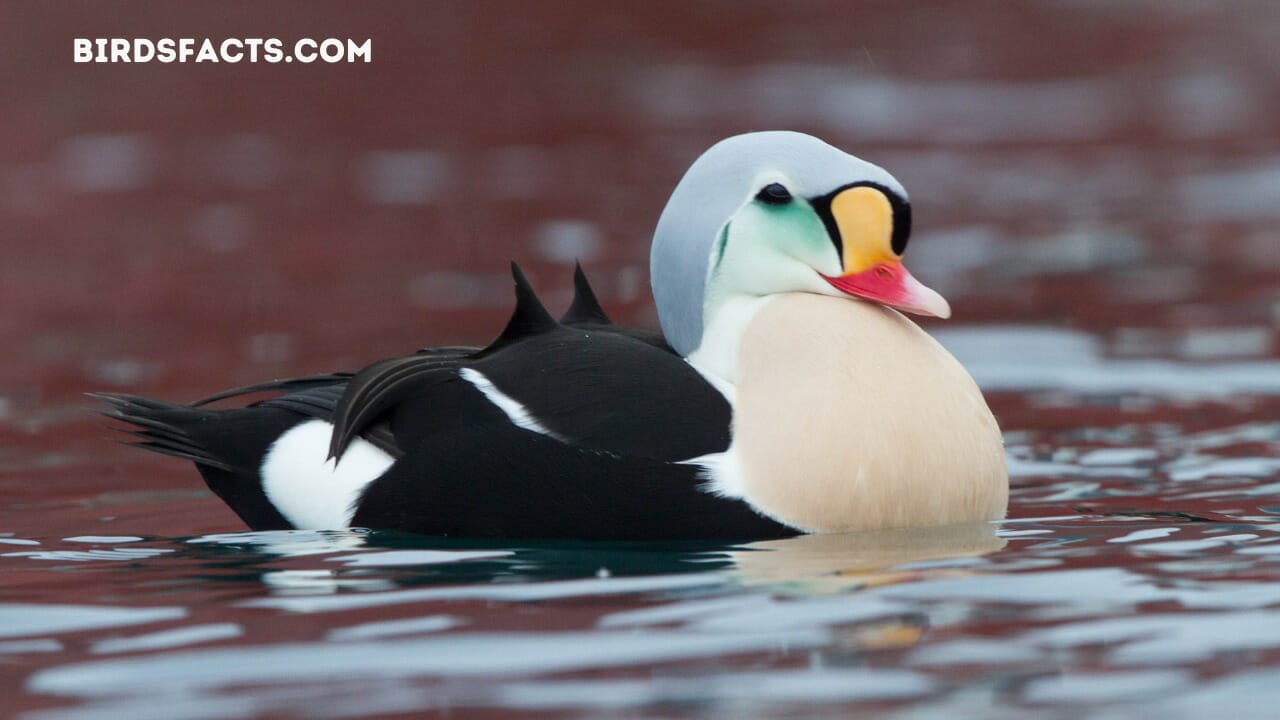
This adaptation allows them to consume saltwater prey without becoming dehydrated. The King Eider is a fascinating and unique species vital to the Arctic ecosystem.
| Characteristic | Description |
|---|---|
| Common Name | King Eider |
| Scientific Name | Somateria spectabilis |
| Native Range | Arctic regions of North America and Eurasia |
| Size | Medium-sized ducks |
| Weight (Males) | Up to 4.5 pounds |
| Length (Males) | 23 inches |
| Wingspan | Approximately 35 inches |
| Top Speed | 50 mph |
| Bill Color | Bright and multi-colored with orange, purple, and yellow shades |
| Lifespan | Around 20 years |
| Maturity (Females) | Around 4 years |
| Maturity (Males) | About 5 years |
| Diet | Mollusks, crustaceans, small aquatic invertebrates, fish, and vegetation |
| Habitat | Shallow coastal areas near rocky shores and islands |
| Predators | Polar bears, Arctic foxes, gulls |
| Breeding Behavior | Gather in large flocks, use distinctive calls to attract mates |
| Nesting Location | Shallow depressions on the tundra or marshy areas |
| Plumage | Ducklings: soft grey; Adults: fully developed feathers at around 75 days of age |
| Population Size | Approximately 625,000 individuals worldwide |
| Threats | Habitat loss, climate change |
| Unique Adaptation | Ability to excrete excess salt through special glands in the head, allowing consumption of saltwater prey |
| Ecological Importance | Vital to the Arctic ecosystem |
Tufted Duck
The Tufted Duck, scientifically known as Aythya fuligula, is a diving duck species commonly found in Europe and Asia. These birds are known to prey on mollusks and aquatic plants, and their distinctive feature is the tuft of feathers on the back of their head. Other names for the Tufted Duck include black-crested duck and tufted pochard.
The estimated population of this species is around 1.5 million individuals, but unfortunately, their biggest threat is habitat loss due to human activities. Tufted Ducks have an approximately 75-85cm wingspan, while their incubation lasts about 26-28 days. These birds can be found in various habitats, such as freshwater lakes and ponds, and they are preyed upon by larger birds, such as eagles and hawks.
Their diet primarily consists of mollusks, insects, and aquatic plants. Tufted Ducks belong to the diving duck family and are currently three recognized species. These birds are commonly found in Europe and Asia, with nesting locations usually close to water sources. Tufted Ducks molt at around one year of age, and their coloration is black and white, with a blue-grey bill. Their skin is waterproof, with a top speed of approximately 70 km/h.
Tufted Duck call:
Male Tufted Duck
Female Tufted Duck
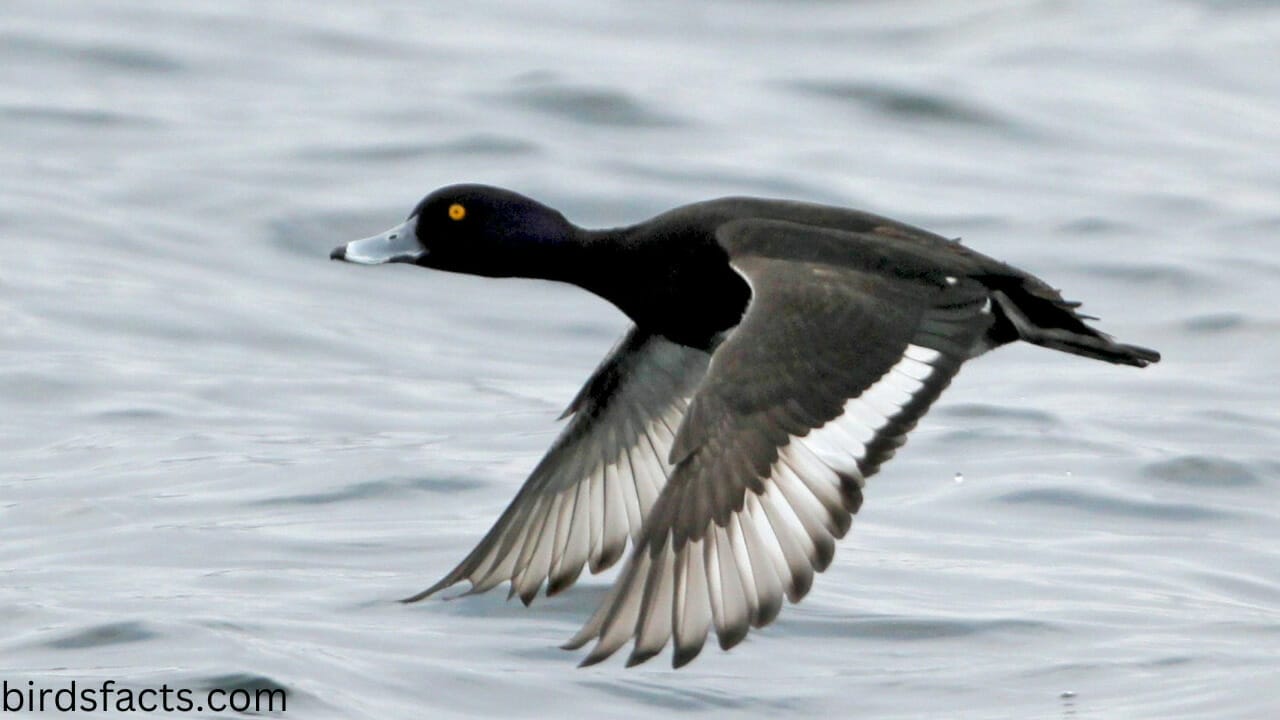
The average lifespan of a Tufted Duck is around 10 years, with adults weighing approximately 600-1200g and being around 40-50cm in length. Despite their small size, the Tufted Duck is a highly adaptable species that can thrive in various habitats, making them an essential part of many freshwater ecosystems.
| Species Name | Tufted Duck |
|---|---|
| Scientific Name | Aythya fuligula |
| Common Names | Tufted Duck, Black-crested Duck, Tufted Pochard |
| Habitat | Freshwater lakes and ponds |
| Distribution | Europe, Asia |
| Population | Approximately 1.5 million individuals |
| Threats | Habitat loss due to human activities |
| Wingspan | Approximately 75-85 cm |
| Incubation Period | 26-28 days |
| Predators | Larger birds such as eagles and hawks |
| Diet | Mollusks, insects, and aquatic plants |
| Family | Diving duck family |
| Species Recognized | Three |
| Nesting Behavior | Close to water sources |
| Molting Age | Around one year |
| Coloration | Black and white |
| Bill Color | Blue-grey |
| Speed | Approximately 70 km/h |
| Lifespan | Around 10 years |
| Adult Weight | Approximately 600-1200g |
| Length | Around 40-50 cm |
| Adaptability | Highly adaptable in various habitats |
Spectacled Eider
The Spectacled Eider, also known as Somateria fischeri, is a unique species of sea duck found in the Arctic regions of North America and Russia. With their striking appearance, Spectacled Eiders are often considered one of the most beautiful ducks in the world. The distinctive feature of this species is the patch of white feathers around their eyes that resembles spectacles. The adult males have a green head, while adult females have a darker brown head. They have a wingspan of up to 39 inches and can measure up to 22-27 inches in length.
Spectacled Eiders feed on marine invertebrates such as mussels, clams, and crabs, and they dive to forage up to 60 meters deep. They typically breed in shallow coastal waters or inland wetlands and can travel long distances to nesting locations. During their breeding season, they display complex courtship behaviors such as head-bobbing, wing-flapping, and calling. Females lay an average of six eggs, and incubation is around 27 days.
The estimated population size of this species is uncertain, but it is believed to be declining, with the most significant threat being habitat loss from oil extraction and climate change. The Spectacled Eider is a vital subsistence bird in arctic Indigenous cultures and is hunted for sport. The lifespan of this species can be up to 20 years, and they weigh around 1.5-2.6 kg (3.3-5.7 lbs) on average.
Spectacled Eider calls:

The Spectacled Eider is a fascinating sea duck species with distinctive spectacles and unique courtship behaviors. They are primarily found in North America and Russia’s Arctic regions and face threats from habitat loss and hunting. Efforts to conserve this species are crucial to ensure its survival.
| Species Name | Spectacled Eider |
|---|---|
| Scientific Name | Somateria fischeri |
| Habitat | Arctic regions of North America and Russia |
| Appearance | Patch of white feathers around the eyes |
| Adult males: green head | |
| Adult females: darker brown head | |
| Size | Wingspan: up to 39 inches |
| Length: 22-27 inches | |
| Diet | Marine invertebrates (mussels, clams, crabs) |
| Foraging Behavior | Diving up to 60 meters deep |
| Breeding Habitat | Shallow coastal waters or inland wetlands |
| Breeding Season | Complex courtship behaviors (head-bobbing, wing-flapping, calling) |
| Eggs | Average of six eggs |
| Incubation Period | Approximately 27 days |
| Population Status | Estimated population decline |
| Threats | Habitat loss from oil extraction and climate change |
| Importance | Vital subsistence bird in arctic Indigenous cultures |
| Hunting | Hunted for sport |
| Lifespan | Up to 20 years |
| Weight | Average weight: 1.5-2.6 kg (3.3-5.7 lbs) |
| Conservation Efforts | Crucial for species’ survival |
Common Pochard
The Common Pochard, also known as Aythya ferina, is a species of diving duck found across Europe and Asia. These medium-sized birds are around 42-49 cm long and weigh about 600-1400 grams. They have a wingspan of approximately 73-80 cm. The Common Pochard can be identified by its most distinctive feature, its round head and short neck.
Their plumage is mainly chestnut brown with black markings on their back and grey on their flanks and belly. They have a lifespan of up to 10 years and reach maturity at around one year old.
These diving ducks commonly inhabit marshes, lagoons, and freshwater lakes. They are omnivorous, feeding on aquatic plants, seeds, and aquatic insects. Their predators include foxes, eagles, and large birds of prey.
The Common Pochard is known for nesting in dense vegetation and reed beds. The female incubates the eggs for about 26-29 days while the male stands guard. After hatching, the young birds learn to fly at around 53-63 days old and are known for molting at around 28 days old.
The estimated population size of this species is around 1.5 million individuals. The biggest threat faced by the Common Pochard is habitat loss due to human development, agricultural changes, and hunting. Interestingly, the males of this species have a unique courtship display where they bob their heads and rear up their back ends.
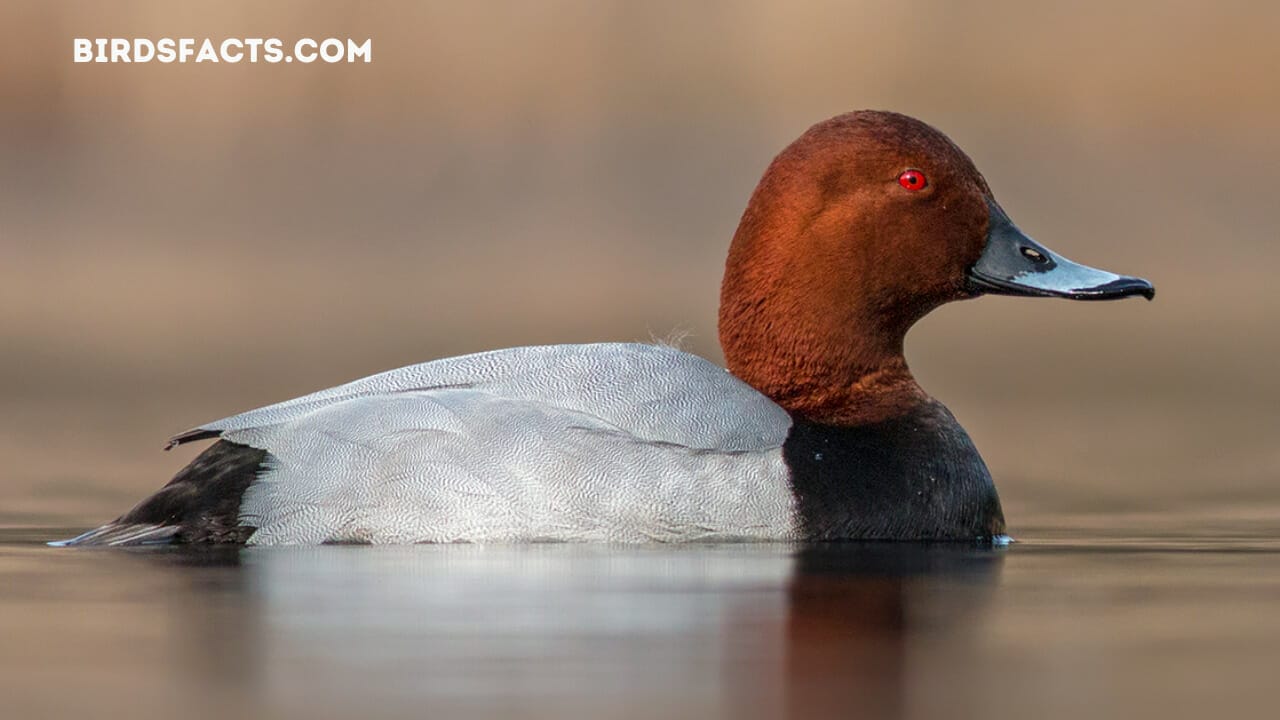
Overall, the Common Pochard is an essential species in the aquatic ecosystem, playing a vital role in maintaining the balance of the food chain. These ducks are fascinating creatures with their distinctive features and unique behaviors. They serve as a reminder of the importance of conservation efforts to protect endangered species and preserve their natural habitats.
| Species Name | Common Pochard |
|---|---|
| Scientific Name | Aythya ferina |
| Average Length | 42-49 cm |
| Average Weight | 600-1400 grams |
| Wingspan | 73-80 cm |
| Distinctive Features | Round head and short neck |
| Plumage | Chestnut brown with black markings on the back, grey on flanks and belly |
| Lifespan | Up to 10 years |
| Maturity Age | Around one year old |
| Habitat | Marshes, lagoons, freshwater lakes |
| Diet | Aquatic plants, seeds, aquatic insects |
| Predators | Foxes, eagles, large birds of prey |
| Nesting Behavior | Nests in dense vegetation and reed beds |
| Incubation Period | Approximately 26-29 days |
| Fledging Age | Around 53-63 days old |
| Molting Age | Around 28 days old |
| Population Size | Estimated 1.5 million individuals |
| Threats | Habitat loss due to human development, agricultural changes, hunting |
| Courtship Display | Males bob their heads and rear up their back ends |
| Ecological Role | Essential species in the aquatic ecosystem, maintaining food chain balance |
| Conservation | Importance of conservation efforts to protect endangered species and their habitats |
Smew
The Smew, scientifically known as Marcellus albellus, is a small, diving duck species in the Northern Hemisphere. One of the most distinctive features of the Smew is its striking black-and-white plumage pattern, with the males having a white body, black back, and black head with white markings, while the females have a gray body and reddish-brown heads.
Smews have a wingspan of around 50-60 cm and an average length of 38-44 cm. They typically inhabit forested areas near northern lakes and rivers, where they feed on a diet of small fish, crustaceans, and insects. Although they are not currently considered threatened, their estimated population is around 20,000-100,000 individuals.
The biggest threat to their survival is habitat loss and degradation due to increased human activity and pollution. Smews typically incubate their eggs for around 26-28 days; the young can fly after 50-60 days. They are considered a type of diving duck and are one of three species in the genus Mergellus.
Other common names for the Smew include the White Nun and the Pied Smew. Their lifespan is around 7-8 years in the wild, and they can weigh up to 700 grams. Smews are not particularly fast, with a top speed of around 50 km/h. They molt at around 1 year of age, with males molting into their striking breeding plumage and females molting into a more drab winter plumage.
Smew Call:
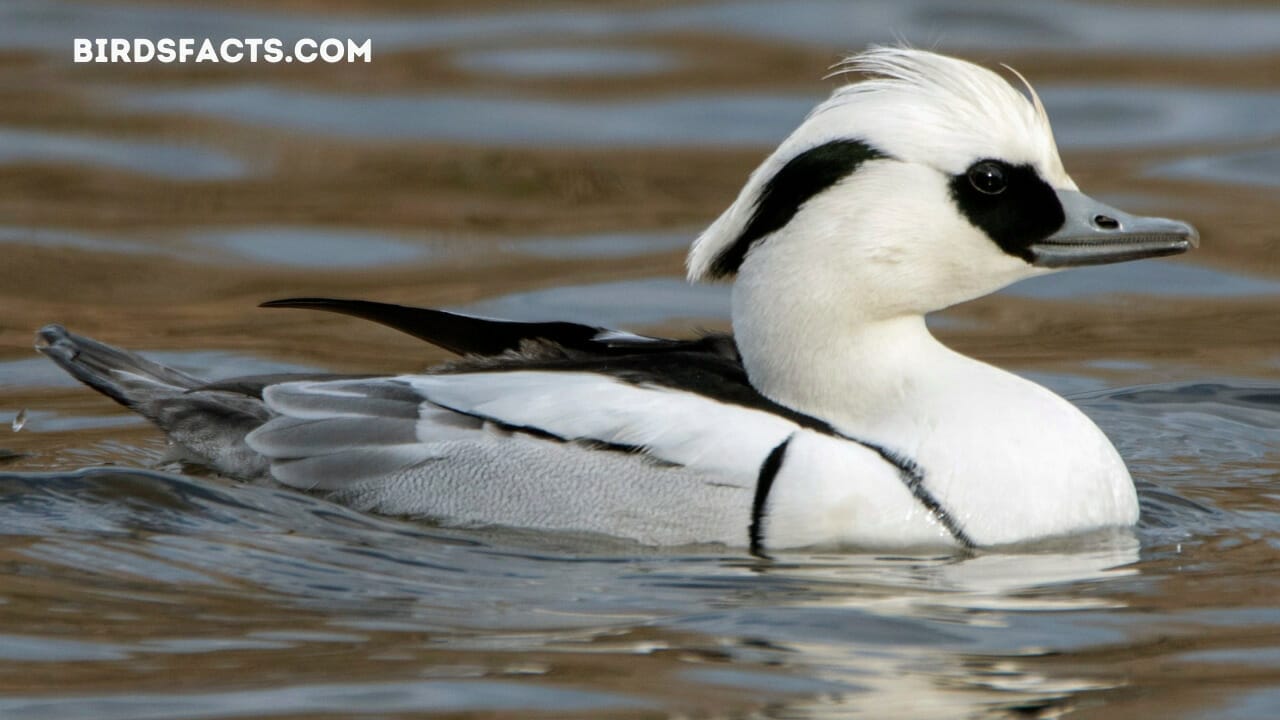
Overall, the Smew is a fascinating and beautiful bird species that play a vital role in the ecosystem of their northern habitats.
| Species Name | Smew |
|---|---|
| Scientific Name | Marcellus albellus |
| Description | The Smew is a small, diving duck species with a striking black-and-white plumage pattern. Males have a white body, black back, and black head with white markings, while females have a gray body and reddish-brown heads. |
| Habitat | Forested areas near northern lakes and rivers |
| Diet | Small fish, crustaceans, and insects |
| Population | Estimated at 20,000-100,000 individuals |
| Conservation Status | Not currently considered threatened |
| Wingspan | Approximately 50-60 cm |
| Length | Average length of 38-44 cm |
| Reproduction | Incubation period of 26-28 days; young can fly after 50-60 days |
| Genus | Mergellus (one of three species) |
| Other Common Names | White Nun, Pied Smew |
| Lifespan | Around 7-8 years in the wild |
| Weight | Up to 700 grams |
| Top Speed | Approximately 50 km/h |
| Molting | Males molt into breeding plumage, females molt into winter plumage around 1 year of age |
| Importance | Plays a vital role in the ecosystem of their northern habitats |
Common Shelduck
The Common Shelduck, also known as Tadorna, is a striking bird species that belongs to the family of Anatidae. They are predominantly found in Europe, Asia, and parts of North Africa. They are known for their distinctive appearance, with an approximately 75-85 centimeters wingspan. Shelducks are usually found in shallow wetlands, estuaries, mudflats, and coastal environments.
When it comes to their diet, shelducks primarily feed on mollusks, crustaceans, and vegetation. They are omnivorous birds, which means they eat both plants and animals. The incubation period of shelducks is around 30 days, and they usually lay anywhere between six to ten eggs. Once the chicks hatch, they are capable of molting at the age of six to eight weeks. Although shelducks are relatively common, the estimated population size is around 400,000 individuals.
However, their biggest threat is habitat loss and hunting. Shelducks have a lifespan of around 20-25 years, can weigh anywhere from 650-1,100 grams, and grow up to 56-70 centimeters. The most distinctive feature of a shelduck is the color of its head, which is black and green. In terms of skin type, shelducks have a feather-covered body and webbed feet. They are fast swimmers and can reach a speed of around 56 km/h. One fun fact about the shelduck is that they are considered monogamous birds and form lifelong pair bonds.
Common Shelduck Call:
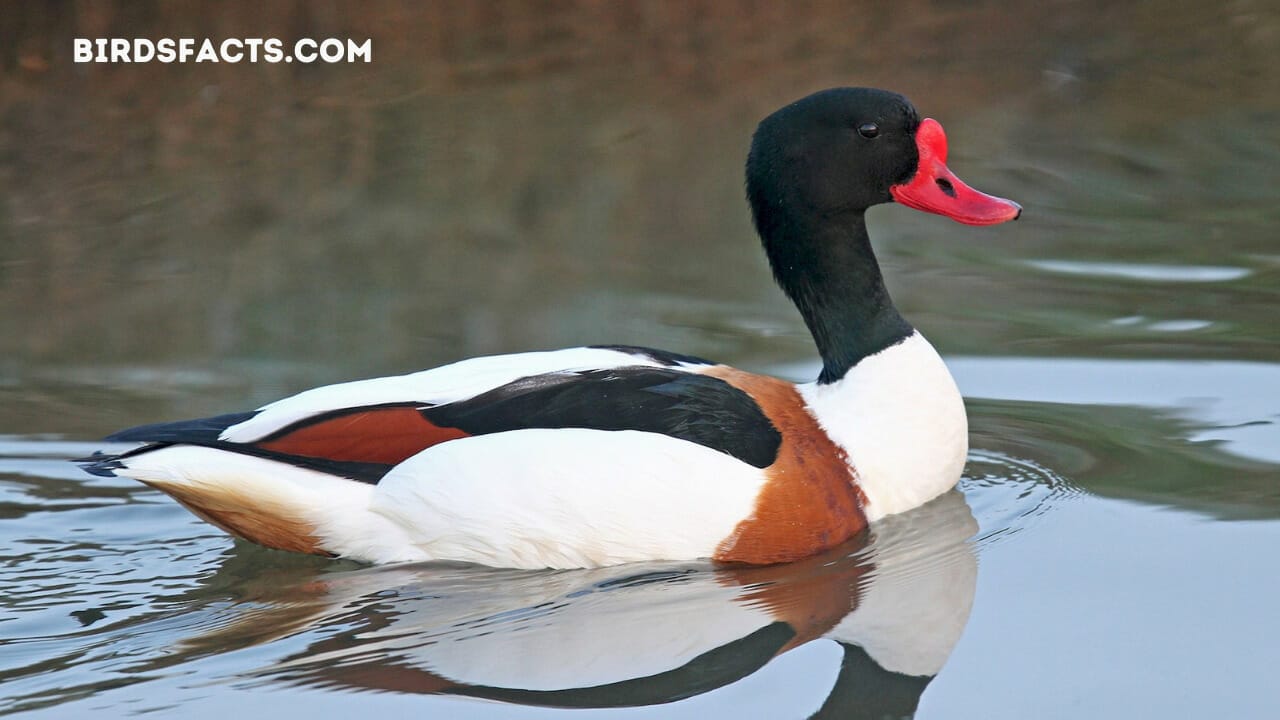
Overall, the Common Shelduck is a fascinating bird species that add to the beauty of the wetlands and estuaries they call home.
| Species Name | Common Shelduck |
|---|---|
| Scientific Name | Tadorna |
| Family | Anatidae |
| Habitat | Europe, Asia, parts of North Africa |
| Wingspan | Approximately 75-85 centimeters |
| Preferred Environments | Shallow wetlands, estuaries, mudflats, coastal areas |
| Diet | Mollusks, crustaceans, vegetation |
| Reproduction | Incubation period: around 30 days |
| Clutch size: 6-10 eggs | |
| Chicks molt at 6-8 weeks of age | |
| Population Size | Approximately 400,000 individuals |
| Lifespan | Around 20-25 years |
| Weight | 650-1,100 grams |
| Size | 56-70 centimeters |
| Distinctive Feature | Black and green head |
| Skin Type | Feather-covered body, webbed feet |
| Swimming Speed | Approximately 56 km/h |
| Social Behavior | Monogamous birds, form lifelong pair bonds |
Muscovy Duck
The Muscovy Duck, known by its scientific name Cairina moschata, is a unique species of duck found in Central and South America. This distinct duck species has various features that set it apart from other ducks. Their most distinctive feature is their red, bumpy face, unique to Muscovy Ducks. These ducks are medium-sized, with a wingspan of up to six feet, and can weigh up to 15 pounds. Adults can reach up to 33 inches, making them one of the larger duck species. TheMuscovy Duck can live up to eight years in the wild and up to 20 years in captivity.
Muscovy Ducks like to reside in areas close to water, in habitats such as forests, swamps, wetlands, and marshes. They feed primarily on seeds, fruits, insects, and small invertebrates. Muscovy Ducks are an omnivorous species with a diet that includes both plant materials and small animals.
Muscovy Ducks are known for their unique appearance and behavior. They do not quack like other ducks but instead produce a hissing sound. They can be called ‘Barbary Ducks,’ ‘Brazilian Duck,’ or ‘Forest Duck.’ The females typically lay between 8 to 16 eggs in their nesting location, where they incubate them for approximately 35 days.
The Muscovy Duck is a prey species often hunted by other mammals and birds, such as coyotes, snakes, and hawks, and breeding. Their biggest threat is habitat destruction from development and human encroachment, as well as other non-native species competing for the same resources.

In conclusion, the Muscovy Duck is a special species adapted to various habitats throughout South and Central America. These interesting ducks have many unique characteristics, from their facial markings, diet, and behaviors, to their distinctive hissing sound. Although they face habitat destruction and predation threats, the estimated population remains stable, with around 1.5 million ducks in the wild.
| Species Name | Muscovy Duck |
|---|---|
| Scientific Name | Cairina moschata |
| Habitat | Forests, swamps, wetlands, marshes |
| Geographic Range | Central and South America |
| Distinctive Feature | Red, bumpy face |
| Size | Medium-sized |
| Wingspan | Up to six feet |
| Weight | Up to 15 pounds |
| Length | Up to 33 inches |
| Lifespan | Up to 8 years in the wild, up to 20 years in captivity |
| Diet | Seeds, fruits, insects, small invertebrates |
| Sound | Hissing sound |
| Other Names | Barbary Duck, Brazilian Duck, Forest Duck |
| Reproduction | Females lay 8-16 eggs, incubation period of 35 days |
| Predators | Coyotes, snakes, hawks, other mammals and birds |
| Threats | Habitat destruction, human encroachment, competition from non-native species |
| Population | Approximately 1.5 million in the wild |
Pomeranian Duck
The Pomeranian Duck, also known as Anas platyrhynchos domesticus, is a domesticated duck breed that originated in Pomerania, a region in northern Germany. These ducks are primarily kept for their ornamental purposes, as well as for their eggs and meat. Pomeranian Ducks prey on predators, including foxes, raccoons, and hawks. One interesting fact about Pomeranian Ducks is that they are excellent egg layers, often laying between 220 to 315 eggs per year.
The estimated population size is currently unknown. The biggest threat to Pomeranian Ducks is predation, particularly from foxes and raccoons. Their most distinctive feature is their pom-pom-like feathers, often on their head and neck. Other names for the Pomeranian Duck include the Pommernente and the Pommerse Eend. These ducks have a wingspan of approximately 90 cm, and their incubation period lasts around 28 days. They are usually raised in a domesticated setting, and their diet consists of grains, insects, and aquatic vegetation.
The Pomeranian Duck is a domesticated breed of the Mallard species of dabbling ducks. They are commonly found in Europe, particularly in Germany and Poland. They usually nest near bodies of water and begin molting at around one-year-old. Their feathers are typically colored in brown, white, and black shades.

The Pomeranian Duck’s skin type is soft and pliable. Their top speed is approximately 50 km/h, and their lifespan ranges from 5 to 10 years. They can weigh between 0.5 to 1.5 kg, and their length is about 40 cm. These ducks are a popular ornamental breed cherished for their unique appearance and utility.
| Characteristic | Description |
|---|---|
| Breed Name | Pomeranian Duck |
| Scientific Name | Anas platyrhynchos domesticus |
| Origin | Pomerania, northern Germany |
| Primary Purpose | Ornamental, eggs, meat |
| Prey on Predators | Foxes, raccoons, hawks |
| Egg Production | 220-315 eggs per year |
| Population Size | Unknown |
| Threats | Predation (foxes, raccoons) |
| Distinctive Feature | Pom-pom-like feathers on head and neck |
| Other Names | Pommernente, Pommerse Eend |
| Wingspan | Approximately 90 cm |
| Incubation Period | Around 28 days |
| Habitat | Domesticated setting |
| Diet | Grains, insects, aquatic vegetation |
| Species | Domesticated breed of Mallard (dabbling duck) |
| Geographic Distribution | Europe (Germany, Poland) |
| Nesting Behavior | Near bodies of water |
| Molting Age | Approximately one year old |
| Feather Colors | Brown, white, black |
| Skin Type | Soft and pliable |
| Top Speed | Approximately 50 km/h |
| Lifespan | 5 to 10 years |
| Weight | 0.5 to 1.5 kg |
| Length | Approximately 40 cm |
| Popular for | Unique appearance, ornamental breed, and utility |
White-winged Scoter
The White-winged Scoter, or Melanitta England, is a sea duck found in the Northern Hemisphere. They are unique in appearance, with a distinctive white patch on their wings that stands out against their otherwise dark plumage. These birds primarily feed on mollusks, crustaceans, and small fish, diving underwater for several minutes at a time in search of their prey.
Interestingly, the White-winged Scoter is known for its ability to dive to depths of up to 200 feet. Despite being a relatively common species, with an estimated population size of around 1 million individuals, their biggest threat is habitat loss and disturbance caused by human activity.
In addition to their unique appearance, White-winged Scoters are known for their nesting habits. They typically build their nests on the ground in areas close to water, such as marshes or bogs. Incubation usually lasts around a month, and the young chicks can swim and feed themselves within hours of hatching. Predators of the White-winged Scoter include foxes, raccoons, and eagles.
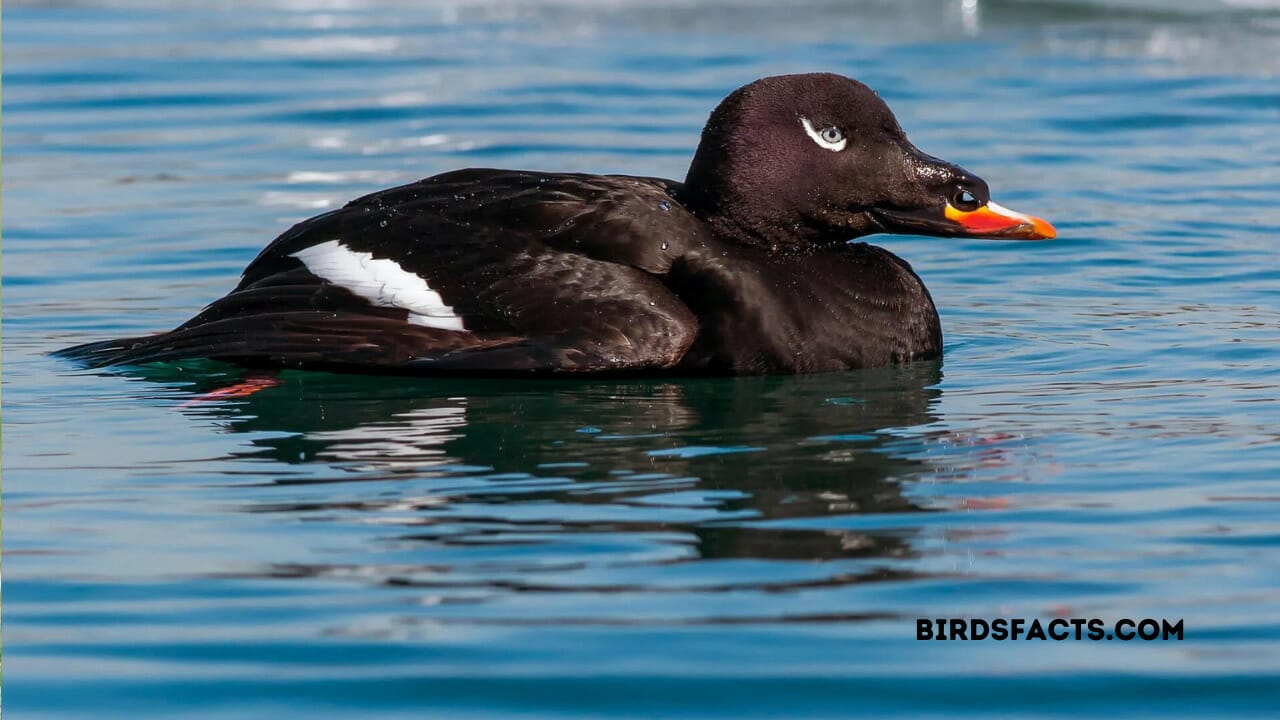
The Type of White-winged Scoter, or Melanitta England, is a sea duck. They are also commonly known as the White-winged Sea Scoter. With a wingspan of about 31 inches and a length of up to 24 inches, these birds can weigh up to 4 pounds and live up to 20 years. They have unique black and white plumage with distinctive white wing patches. The White-winged Scoter is also known for achieving fast speeds of up to 55 miles per hour while flying. However, underwater, they are much slower, moving around 6-7 miles per hour.
| Species | White-winged Scoter |
|---|---|
| Scientific Name | Melanitta England |
| Common Names | White-winged Sea Scoter |
| Distribution | Northern Hemisphere |
| Appearance | Distinctive white wing patches, dark plumage |
| Habitat | Sea, marshes, bogs |
| Diet | Mollusks, crustaceans, small fish |
| Diving Depth | Up to 200 feet |
| Population Size | Approximately 1 million individuals |
| Threats | Habitat loss, disturbance from human activity |
| Nesting Habits | Ground nests near water |
| Incubation Period | Around a month |
| Predators | Foxes, raccoons, eagles |
| Wingspan | Approximately 31 inches |
| Length | Up to 24 inches |
| Weight | Up to 4 pounds |
| Lifespan | Up to 20 years |
| Flight Speed | Up to 55 miles per hour |
| Underwater Speed | Around 6-7 miles per hour |
What is a Black and White Duck?
There are many beautiful black and white ducks out there. Some of the most well-known breeds of these ducks include the Australian Black Duck, the Muscovy Duck, and the Harlequin Duck. These ducks can be found worldwide but are trendy in North America.
These ducks are very different from others because they have black bodies with white heads and necks. The overall color is usually some shade of grey, but some individuals can be quite brightly colored. They are graceful animals and make great pets. They are also suitable for hunting because they swim well underwater and have substantial bills that can trap food.
Beautiful Black and White Duck Breeds
There are many beautiful black and white duck breeds, but the three most popular are the Mallard, the pintail, and the American Black Duck. All three of these breeds have striking plumage that is incredibly beautiful. The Mallard is perhaps the most well-known of the black and white ducks because its feathers are a deep black with a very white ” mantle ” around its neck. The pintail has a similar coloring, but its wings and tail are a bright turquoise blue. The American Black Duck is slightly different in that it has a much more uniform black color all over its body. Regardless of your breed, you will surely love their graceful appearance.
The black and white duck is a beautiful duck species that includes a variety of types such as the long-tailed duck, ring-necked duck, magpie duck, goldeneye duck, and crested duck. These medium-sized ducks are known for their stunning black and white plumage, with black feathers on their bodies and a white wing. Some types of this duck, like Pomeranian ducks, also have white plumage. These farm ducks are great for egg production, with female ducks laying white eggs.
The black and white plumage is also common among Cuthbert’s ducks, who also have white bodies with a black breast, while Runner ducks have a white stripe on their bodies. Despite their striking appearance, black and white ducks don’t have a specific type of breed, but they are recognized by the American Livestock Breeds Conservancy.
These small ducks feed on a variety of foods and are a joy to watch as they roam around ponds and fields. If you admire the beauty of black and white ducks, learn more about these captivating waterbirds and how you can help preserve their species for generations to come.
The black and white duck is a fascinating species that can be found all over the world. These ducks have unique features such as white heads and white crests, contrasting with their black bodies. Some black and white ducks have white cheeks while others have white faces. The males of this species often have white coloring, while the females are mostly black.
These large sea ducks are commonly found in bodies of water such as lakes, ponds, and rivers. Their backs are typically black, and they have black tails. Some species of black and white ducks include ruddy ducks, female muscovy ducks, shetland ducks, cuddly ducks, and even chocolate and white ducks.
Despite their common black and white coloring, some ducks may have additional color variations such as gray with white, large white patches, or bodies that are mostly white with black accents. In many parts of the world, the black and white duck is the common duck species. They are a popular choice for birdwatchers due to their large size and distinctive appearance. During migration, these ducks can be seen flying in flocks across the sky.
Overall, black and white ducks have a unique appearance and are a standout species among other birds in their habitat.
What are the Different Types of Duck Breeds?
There are many types of ducks, but the most popular ones are black and white. These breeds are known for their beautiful coloring and skilled swimming abilities. Other popular duck breeds include the Muscovy duck, a cross between a black duck and a mallard, and the poodle duck, a cross between a domesticated duck and a poodle.
How to Care for a Black and White Duck
If you have black and white ducks, you must take special care of them to keep them healthy. You must provide them with enough water, food, and shelter. You should also make sure that they are kept away from other animals so that they can protect themselves.
What are the Beautiful Black and White Duck Breeds?
There are many beautiful black and white duck breeds, but the two most well-known are the Aylesbury Duck and the Labroquet. Aylesbury Ducks are known for their large size and striking black and white plumage. They have a long neck, a broad chest, and long legs. The Labroquet is a smaller breed with a more ornamental pattern of black, white, and blue markings. Both species are very friendly and easy to care for.
How to Choose the Right Duck Breed for You
Many beautiful black and white duck breeds exist, but which is the best for you? Here’s everything you need to know about choosing the right duck breed for your home.
First, decide what type of water you’ll keep your ducks in. Some duck breeds, like the Muscovy Duck, are great for lakes and ponds, while others, like the Brahma Duck, are better suited for rivers or streams.
Next, consider your lifestyle. Are you going to be keeping your ducks around other animals or people? Certain bird breeds can get along well with others, while others may be less social.
Finally, consider what kind of personality you want your duck to have. Some ducks are more laid back, while others might be more active.
The Best Places to Hunt Ducks in the U.S
There are many beautiful black and white duck breeds in the United States. These ducks are great for hunting because they are fast and fly well. Here are the five best places to hunt ducks in the United States:
1. The Great Lakes states- Many large lakes exist in the Great Lakes states, including Superior, Huron, Michigan, Erie, and Ontario. These lakes are great for hunting black and white ducks because they have plenty of water and wildlife.
2. Illinois- In Illinois, you can hunt big mallards on the numerous small rivers and creeks throughout the state. This is a great place to get close to these birds while still having some space to run if necessary.
3. Kansas- The Wichita Mountains Wildlife Refuge in Kansas is home to some of North America’s largest concentrations of black and white ducks. You can hunt these birds from a boat or on foot using firearms or bow and arrow.
4. Minnesota- The Mallard Hunting Area near Worthington is one of the best places in Minnesota to hunt ducks. This area has several ponds holding large ducks during migration season. You can also hunt these birds on private land across Minnesota using firearms or bows and arrows.
5. Virginia- Black Ducks can be hunted throughout much of Virginia all year, but their greatest concentration is during spring migration when they travel north along the Atlantic Coast\.
Conclusion
Thank you for reading our article on beautiful black and white duck breeds. In it, we provide a brief overview of each species and some pictures of them in action. We hope this information has been helpful and that you can find the perfect duck breed for your needs!
FAQ
What kind of duck is black and white?
What kind of duck is black and white? The answer is the Magpie Duck. This breed of domestic duck can be recognized for its distinctive black and white markings. Magpie ducks are a medium-sized breed known for their docile personality and excellent egg layers. They were initially bred in the United Kingdom in the early 20th century and have since become popular in the United States and other countries worldwide.
Can you get black and white ducks?
Yes, it is possible to get black and white ducks. Some breeds, such as the Magpie and Runner ducks, have black and white feather patterns. These ducks are famous for their striking appearance and are often used for ornamental purposes. It’s important to note that different breeds have different care requirements, and not all black and white ducks will have the same temperament or characteristics.
How rare is a hybrid duck?
Hybrid ducks are less common than purebred ducks. While it is common for ducks of different breeds to interbreed in the wild, producing a hybrid duck, these are still relatively uncommon. Hybrid ducks can occur naturally or be bred intentionally, but because there are so many different duck breeds available, hybrids are still relatively rare compared to purebred ducks.
Is American black duck rare?
The American black duck is considered a declining species but not necessarily rare. The population has decreased by about 50% over the past few decades due to habitat loss, hunting, and hybridization with the Mallard. However, the American black duck can still be found in various locations throughout North America, particularly in the eastern part of the continent. Conservation efforts are ongoing to help recover the population of this unique waterfowl species.
Can a goose breed with a duck?
A goose can only mate with another goose. A duck can mate with a goose, but it is scarce. To mate, a goose must have two mature eggs. If a goose and a duck have mature eggs, the goose will lay the egg. If the goose lays the egg, it will be fertilized by the duck. The duck will then incubate the egg until it hatches.
Further Reading
You may also check out:
- Black Birds In Florida
- Bird with Red Beak
- bird with orange chest
- Owls In Arizona
- Zenon Unlock Tool 2.2
Thank you for reading!





